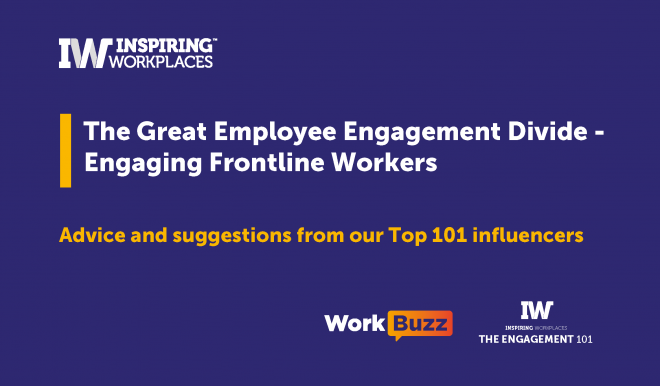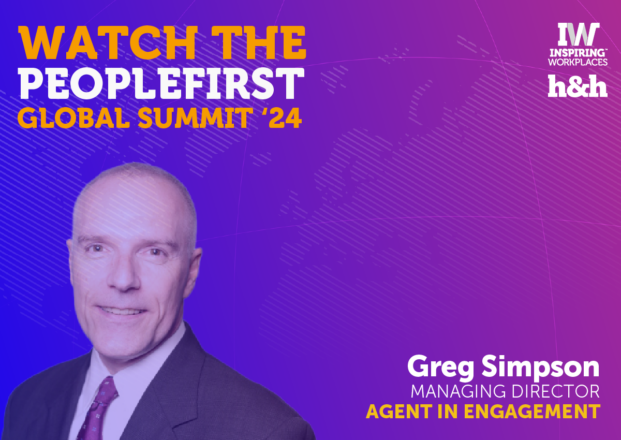
24th October 2023
Unlocking Workplace Happiness Is Possible — and Worth It

Being happy at work isn’t just a win for employees; it’s also a win for employers. Research shows a causal link between happy workers and a 13% increase in productivity. On the flipside, unhappiness at work costs the world $7.8 trillion in lost productivity, equal to 11% of global GDP. But too many of us are disconnected, disengaged, and bored at work. 50% of the global workforce is quiet quitting and 18 percent are loud quitting – sharing openly that they are unhappy at work. Social media trends like #QuietQuitting and #ActYourWage have reached over 1.2 billion views and their virality confirms that we’re all still feeling the effects of chronic stress and burnout from the pandemic. Obviously, the current state of workforce unhappiness is a big problem to solve. Happiness at work has to come from a deeper, more intrinsic connection to why we’re there. A culture of autonomy, belonging, and purpose comes from a shared vision, and right now, it’s fair to say that many companies and their employees are simply not seeing eye-to-eye. This article covers three steps organizations can take to turn that around.
From the original article written by Jennifer Moss and published in the Harvard Business Review.
For many of us, being an adult at work today is like being a kid at a school without art, gym, and recess — no fun. And, that’s a huge reason why so many of us are disconnected, bored, and disengaged.
Gallup data confirms this. After trending upwards, engagement hit its lowest in a decade with younger workers and women — the most unhappy people at work. 50% of the global workforce is quiet quitting and 18% are loud quitting — sharing openly that they are unhappy at work. Social media trends like #QuietQuitting and #ActYourWage have reached over 1.2 billion views and their virality confirms that we’re all still feeling the effects of chronic stress and burnout.
For many of us, our perspective has shifted from what we do for a living to how we want to live. New research from MIT finds that our health and happiness at work is not an afterthought, but rather a driving force in our decision to take, stay at, or leave a job.
Being happy at work isn’t just a win for employees; it’s also a win for employers. Novel research from Oxford has found a causal link between happy workers and a 13% increase in productivity. On the flipside, unhappiness at work costs the world $7.8 trillion in lost productivity, equal to 11% of global GDP.
Obviously, the current state of workforce unhappiness is a big problem to solve. But to get there, we need to start walking towards each other with small, incremental steps:
Step 1: (Re)Imagine Flexibility
The pandemic forced us to push through a thorny, almost unwalkable path, but we did it. Going back would mean fumbling through the forest again. Both consciously and subconsciously, we’re resisting.
Being able to pick up kids after school or reducing the daily grind of commuting for hours in traffic reduced friction between work and life. So why claw it back? Especially when evidence shows that employees with more autonomy are good for business.
A 2023 International Labor Organization report found that greater flexibility — from staggered start times, to shift-sharing, to remote working options — leads to greater productivity and improved work-life balance. A global survey of 28,000 full-time employees by Cisco found that 82% said that the ability to work from anywhere has made them happier. Gallup data found that, “the optimal engagement boost occurs when employees spend 60% to 80% of their time working off-site.” Gallup found that this group — those who work remotely 60% to 80% of the time — is also the most likely of all employees to strongly agree that their engagement needs related to development and relationships are being met.
“The job market has changed and workers appreciate choice and flexibility more than employers realize,” explains Paul McDonald, senior executive director of management consulting firm Robert Half. “While salary is still top-of-mind for workers, it’s certainly not the only thing that matters.”
Especially for women. Despite 2.2 million job losses during the pandemic, today women between the ages of 24–54 represent 78% of the labor force, surpassing peak rates in 2019. The work from home revolution may be playing a big role in that surge. But Aki Ito, in her piece for Business Insider, warns that those gains could be lost with the push to return to the office.
Last year, 41% of women worked from home — compared with only 28% of men. Ito worries that “if that trend continues, we could wind up creating a two-tier workforce in which women work from home in lower-paid, dead-end roles while men come into the office for higher-paid, management-track positions.”
And what about the 60% of the workforce that can’t work from home?
Psychologist, best-selling author, and Chair of BetterUp’s Center for Purpose and Performance, Adam Grant, told me that we’re having an overly narrow conversation about flexibility — in that the conversation is all about where we work. He suggests that flexibility should be about freedom. “Make a list of things workers want to be free of and things they want to have the freedom to do. And then you can play each of those out alongside choices about where we work, when we work, and how much we work.”
Flexibility is now part of the post-pandemic zeitgeist. In 2023, when the big three auto manufacturers went on strike, a four-day workweek was a top demand.
We need to reimagine flexibility in every sector and in every role type; it can’t be exclusive to certain roles. We are optimized when autonomy is abundant. It’s also the key to unlocking both a happy and a high-performing workforce — a happiness win-win.
Step 2: (Re)Build Belonging
The average person will spend 81,396 hours at work. Imagine all that time without positive social interaction. It would be safe to say that our happiness would be negatively impacted.
Tech acceleration has made connecting with each other both easier and harder. With a 252% increase in Teams Meetings alone and daily active Zoom users growing by 2,900% since pre-pandemic days, we may be hyper-connected, but we’re lonelier than ever. Today, only three in 10 workers have a best friend at work.
Jon Clifton, CEO of Gallup, told me in an interview, “We’re in a global crisis of loneliness, which was happening even before the pandemic. Some 20% of adults worldwide say they have no one to turn to in their hour of need.”
Building workplace community is often an afterthought to getting work done, but Clifton says that Gallup data shows that “since the start of the pandemic, having a best friend at work has had an even greater impact on important outcomes — such as employees’ likelihood to recommend their workplace, intent to leave, and overall satisfaction.”
The latest 2023 Global Culture Study by O.C. Tanner found that organizations who score high on the Community Index — where employees feel like they belong and contribute to shared goals in meaningful ways — have a 62% increase in employee-estimated tenure at their current workplaces.
Dr. Beth Schinoff, Assistant Professor of Management at the University of Delaware, says that to improve our relationships in a meaningful way, we need to work on our “relational cadence” — a term that describes how we match and support our peers’ work styles. “We do that by asking our coworkers about how they work and who they are,” says Schinoff. “We make it a habit to have work-style-related conversations, being genuinely curious and interested in your coworkers as people,” she advises.
To encourage behaviors of a happier culture, we all need to communicate when we’re engaging in free time and self-care — like getting fresh air or taking some creative thinking space. Leaders who model self-care establish healthy norms within peer groups. It also reduces unhealthy competitiveness. Shared goals are known to foster collaboration, which is good for bolstering friendships.
With the increase in hybrid and remote work making it hard to bump into someone at the watercooler, and with increased workloads downgrading social interactions, we may need to schedule serendipity into our interactions with coworkers. How can you plan for chance encounters?
Bring back recess.
According to data by Great Places to Work, employees are three times more likely to experience well-being if they work in a fun environment.
But fun shouldn’t be forced. The best companies ask what their people want, and consider all employees inclusively. Consider Google: Yes, they have plenty of perks — from swimming pools to putting greens — but that’s not at the heart of why the company is fun. According to employees, the fun comes from people and purpose. Googlers’ “20% time” gives them one week per year to work on a project of their choice, which fosters a culture of curiosity. Learning together and project collaboration is enthusiastically supported. Workspaces are designed to support diverse working styles — from small groups to large gatherings to solo work. Ad hoc and planned events are everywhere, such as hobby clubs or sports activities — there is no one size fits all.
Despite recent layoffs, Google still ranks as one of the top companies across Canada, the U.S., the UK, France, and Germany. Over 40,000 reviews show a 93% approval rating for their CEO, Sundar Pichai.
Or, consider these other examples: Every third Wednesday of the month, Visa holds an ice cream social where employee resource groups (ERGs) set up booths that employees can visit and decide if they want to join. Airbnb believes that travel is a great way to have fun, as is evidenced by one of their most beloved perks — a $2,000 annual travel stipend for employees to stay in any one of their Airbnbs worldwide.
When I spoke with Laura Fuentes, Executive Vice President and Chief Human Resources Officer at Hilton, she shared the importance of making travel more accessible for Hilton employees. They overhauled the old platform so employees can get easier access to thousands of unused rooms all over the world at a deep discount. In addition, team members get 100 nights to share with their friends and family at the same rates. In an era of vacation deprivation, this is crucial. People who don’t take time off are more likely to resent their coworkers and be less social.
Perks — like putting greens — only work if people feel permitted to use them. If we want to get to the roots of fun at work, it’s boils down to how it’s modeled at the leadership level. Leaders need to be joiners. Time allotted for recess can lead to serendipitous connections that spur deeper friendships and connections in our work lives.
To build belonging, we must go slower. Be intentional about what makes someone happy at work, and conversely, what doesn’t. Look out for patterns by paying closer attention to what your employees want and asking direct questions, such as “Do you feel connected to your community at work?” and “We’re open to feedback – how can we increase a sense of belonging for you and others?”
Step 3: (Re)Store Purpose
Do you know an inspiring leader? Nominate them today: Inspiring Leaders Awards 2023.
Are you an inspiring workplace? Then register for the Inspiring Workplaces Awards 2024.
Join our community here, for free and access The Inspire Hub Forum to connect directly with your peers who share the same purpose.





